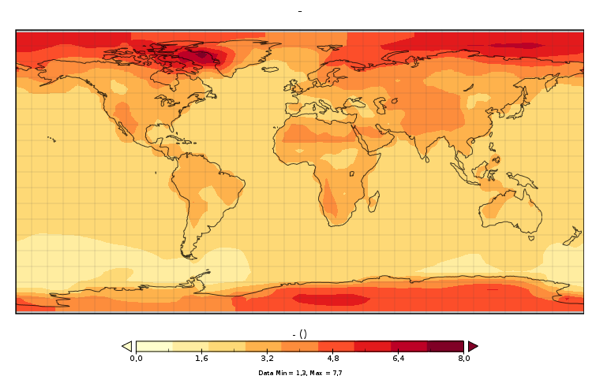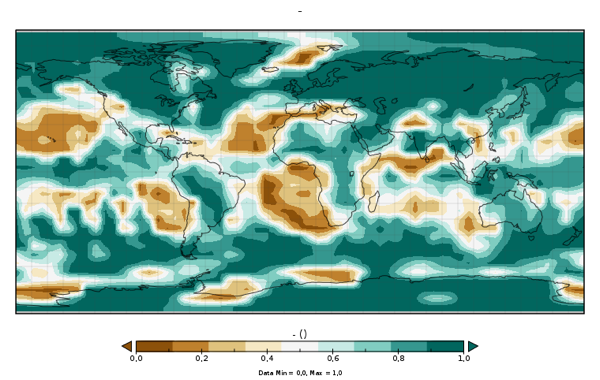Scenario 7: CPH Annex1 Forever
Context
The scenario illustrates a partial agreement where only Annex 1 countries commit in emission reductions, as defined by the less strict pledges of the Copenhagen Accord, while other countries don't contribute to any emission efforts. In TIAM, the emissions of the Non-Annex 1 countries are limited to their levels in the reference case. In other words, no emission leakage is allowed, resulting for example of an increase of energy extraction (delocalisation of activities) or consumption (rebound effect) in these countries given the mitigation efforts of Annex 1 countries. Also, in TIAM, trade of carbon permits is allowed only within Annex 1 countries; it is limited to 10% in 2020 and 20% from 2020, of the required emission reduction of each country; the trade associated with the Clean Development Mechanism is not considered.
Climate

Please note that results below from GENIE are relative to 2005. In average, the temperature change relative to pre-industrial is 0.76 degrees higher.


+ SAT warming average in 2105 relative to 2005
+ SAT warming standard deviation in 2105 relative to 2005
+ SAT warming average in 2050 relative to 2005
+ SAT warming average in 2030 relative to 2005
+ Probability of a precipitation increase (in %)
Techno-economy analysis (long term)
In Annex 1 countries, emissions are reduced by 17% in 2020 and 18% after 2030 compared to 2005 emissions, while they increase by up to 30% in the Reference case). This reduction remains visible at the World level: World emissions increase by 7% in 2020, 27% in 2030 and by more than 160% at the end of the century compared to 2005, instead of 14%, 37% and more than 170% in the Reference case. The main energy changes in Annex 1 countries concern the electricity generation: coal is substituted by renewable, mainly wind generation. Final energy generation is almost not modified; in other words, the pledges are too small to induce large changes in the energy system except in the electricity generation. The energy system of Non-Annex 1 countries is not really affected except in terms of trade of energy commodity; for example, countries which exported coal to Annex 1 countries can now export more coal to Non-Annex 1 countries; some Annex 1 countries (eg. USA) also decide to export some of their resources, whose domestic consumption has decreased, to Non-Annex 1 countries; following this dynamic, China imports more coal and uses less of its domestic coal resource compared to the Reference case.
+ Combination with a long-term climate target: In order to evaluate if long-term temperature increase can be limited to 2°C when a partial agreement, limited to Annex 1 countries, is implemented in the mid-term horizon, it is assumed that an international treaty involving the perfect cooperation of all countries is found and applied from 2040: all countries, including Non-Annex1 countries, cooperate and mitigation efforts are done where they are more efficient. In this case, the 2°C cannot be respected, given the mitigation options available in the model. In other words, reduction of emissions by developing countries cannot be delayed until 2040, especially in the case where industrialized countries don't commit to early deep reductions, what appears to be the case in the current negotiations if developing countries don't make serious mitigation efforts.
+ Cost of the strategy: Net present value (NPV) of the cost of the strategy given as a % of the NPV of the GDP cumulated over the century: 0.043%
Economy analysis (mid term)
several mid-term economic sub-scenarios may be explored:
+ no CDM
+ CDM limited to 5%*
+ no CDM, CO2 permit purchasing allowed up to 50%*
+ CDM limited to 5%*, CO2 permit purchasing allowed up to 50%*
*of the total allocated emission permits volume.
Emissions
+ Emissions of CO2, CH4 and N2O in GtC until 2105
Energy / Technology
+ Cumulative sequestrated carbon in geological sinks: 7 GtC
+ Primary energy (assuming FEQ=1 for non fossil energy) in EJ
+ Electricity generation in billions of kWh
+ Energy consumption by end-use sectors, including non-energy purposes in EJ

